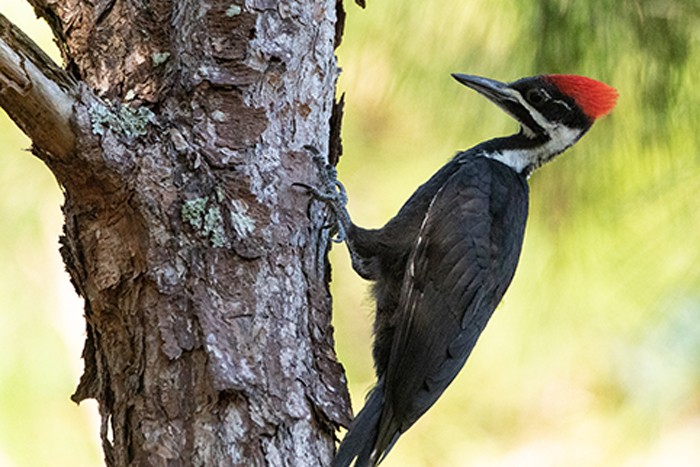Woodpeckers in Florida Population: Species Overview and Conservation
Woodpeckers in Florida Population: Species Overview and Conservation
Blog Article
Unveiling the Tricks of Woodpeckers: Behavior, Environment, and More
Woodpeckers, with their unique behaviors and specialized adjustments, have long interested researchers and nature fanatics alike. These amazing birds possess a variety of appealing keys that shed light on their survival methods, habitat preferences, and complex communication techniques. By uncovering the mysteries bordering woodpeckers' actions and environment selections, a deeper understanding of these avian wonders emerges, supplying a glance right into their fascinating world. What makes these birds truly outstanding, and exactly how do they navigate their setting with such precision and skill? Allow's explore the fascinating realm of woodpeckers and unravel the enigmatic information that make them such intriguing subjects of study.
Woodpecker Habits Insights
In analyzing woodpecker habits, a remarkable display screen of specialized skills and adaptations arises, dropping light on their exceptional environmental particular niche. Woodpeckers, recognized for their unique drumming on trees, have a variety of behavioral traits that add to their survival and success in their environment.
In addition, woodpeckers display a distinct feeding actions characterized by their capability to remove pests from tree bark using their specialized beaks. Their lengthy, barbed tongues aid in catching prey, while their solid neck muscle mass provide stability and accuracy throughout pecking movements. This feeding technique permits woodpeckers to accessibility covert insect larvae and extract them with exceptional effectiveness.
Environment Preferences and Selection
What variables influence the habitat choices and choice of woodpeckers? Woodpeckers are very adaptable birds known to populate various environments worldwide. They do show choices for certain environment attributes. One critical element influencing woodpecker habitat option is the accessibility of suitable nesting sites. Woodpeckers generally like woodlands with a mix of mature trees that offer adequate chances for cavity excavation. These tooth cavities work as important nesting and roosting websites for woodpeckers and are vital for their reproducing success.
In addition, woodpeckers show a choice for environments with a plentiful supply of food resources. They are largely insectivorous, preying on beetles, ants, larvae, and various other pests discovered in decaying wood or tree bark. For that reason, woodpeckers often tend to prefer woody locations with a varied insect population to fulfill their nutritional needs.
In addition, the existence of dead or rotting trees is an additional crucial aspect in woodpecker habitat choice. These trees not only supply food sources yet also use ideal substratum for dental caries excavation. Dead trees are vital for the upkeep of healthy and balanced woodpecker populations, as they play a crucial role in the woodpeckers' life process and environment dynamics.
Feeding Routines and Diet Plan Structure
Woodpeckers demonstrate a specialized feeding habits concentrated on foraging for pests within different habitats. In addition to bugs, woodpeckers also take in tree sap, fruits, nuts, and seeds, adding variety to their diet plan depending on the period and accessibility of food resources.
The foraging techniques of woodpeckers are well-adapted to their arboreal way of living (Woodpeckers in Florida). Their ability to excavate wood not only gives them with food but likewise assists in developing nesting cavities and establishing territories. Woodpeckers play a critical function in maintaining the health and wellness of forests by regulating insect populations Get More Information and aiding in the decay of timber. Recognizing their feeding behaviors and diet plan structure is vital for preservation efforts targeted at maintaining these unique and important birds.
Drumming Sounds and Interaction
Making use of rapid drumming sounds on different surface areas, woodpeckers employ a distinct type of communication to indicate region boundaries and attract mates. This drumming behavior is not only a means of communication however also acts as a way for woodpeckers to establish their existence within a certain location. The intensity, speed, and pattern of the drumming can communicate vital details to other woodpeckers in the vicinity.
Woodpeckers utilize drumming noises to introduce their presence in a territory and to caution off prospective trespassers. The loud and recurring nature of the drumming functions as a clear signal to various other woodpeckers that the location is currently declared. This helps in lowering problems and lessening physical battles in between individuals.

Survival Adaptations and Specialized Anatomy

Final Thought
In final thought, woodpeckers exhibit distinct behaviors, such as drumming sounds for interaction, and have specialized anatomy for survival in their picked environments. Their feeding practices and diet plan composition better show their adaptability to numerous atmospheres. By understanding these facets of woodpeckers, researchers and conservationists can much better secure and maintain these fascinating birds and their environments.
Report this page